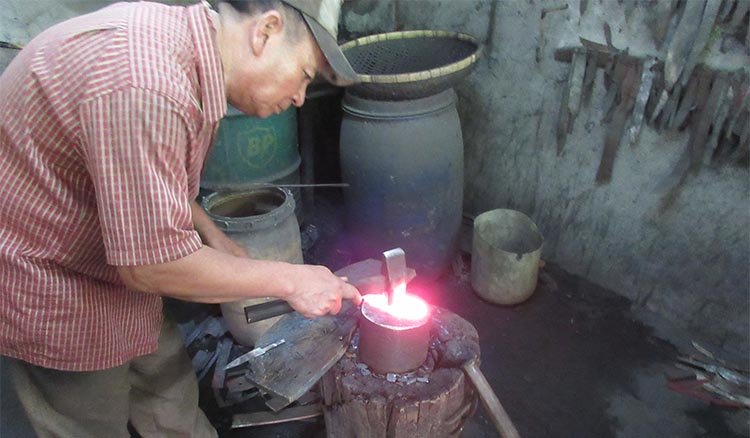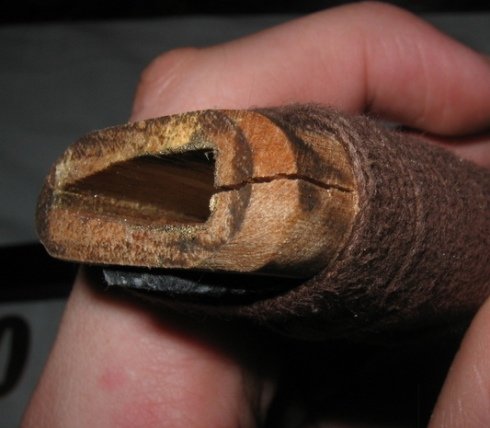Recent Articles
-
Christmas Sword Buying Guide 2025
Dec 03, 25 10:53 PM
How Swords Are Made
The Basics
It is important to understand how swords are made, even if you never intend to make a sword in your life. If you are a collector or a sword enthusiast who DOESN'T at least have a basic idea of how they are made and the various processes used to make them, it is all too easy to fall prey to unscrupulous sellers who claim the impossible or try to trick you out of your hard earned money by overcharging.
If you have come to this page wondering how to make swords at home rather than how swords are made by sword manufacturers, click here
But more than this, if you don't understand and appreciate how swords
are made, you will have false expectations and end up disappointed and
waste both your time and your money buying swords that simply will not
suit your personal requirements..
Well by the end of this
article, you will not only understand more about what goes into making a
sword than 95% of other sword collectors, but you will also learn how
to cut through any marketing BS and make it so much easier to get a
sword that suits your needs at the price you are willing to pay for it.
So let's get started..
QUICK JUMP MENU
- Sword Making the Chinese Way
- South East Asian Micro-Forges
- Indian Sword Forges
- Swords made in the West
- Traditional Sword Making in Japan
- What to expect by price point
How Swords are Made in China
(Welcome to Hammertown)
As around 80% of all fully functional swords being sold today are made in China, it is especially important for collectors to know what is REALLY going on over there. Contrary to popular belief, Chinese made swords do not automatically equate to poor quality (just like an iPhone or Android right?) - they make swords according to customer demand at at various price points, from wall hangers to extremely high end museum quality pieces that are worth tens of thousands of dollars (and in some cases, much higher yet again).
After all, China has been a center of sword making for over 2,500 years, creating two handed fighting swords 1000 years before they appeared in the west, and taught the Japanese how swords were made using advanced techniques
such as differential hardening, folding and lamination that they used to form the techniques to make the legendary Katana -
so let there be know doubt, China know how all the secrets of how swords are made and there are very few methods that they cannot reliably reproduce.
Brief Interview with one of the Forge Owners in China
Unfortunately, some sword sellers - especially those from mainland China operating on eBay, would like you to believe that their bargain basement swords are made by the Master Smiths themselves..
When in fact, maybe 75% of all swords under $300 are made in one place by blue collar workers - a single workshop known colloquially as "hammer town" in Longquan China.
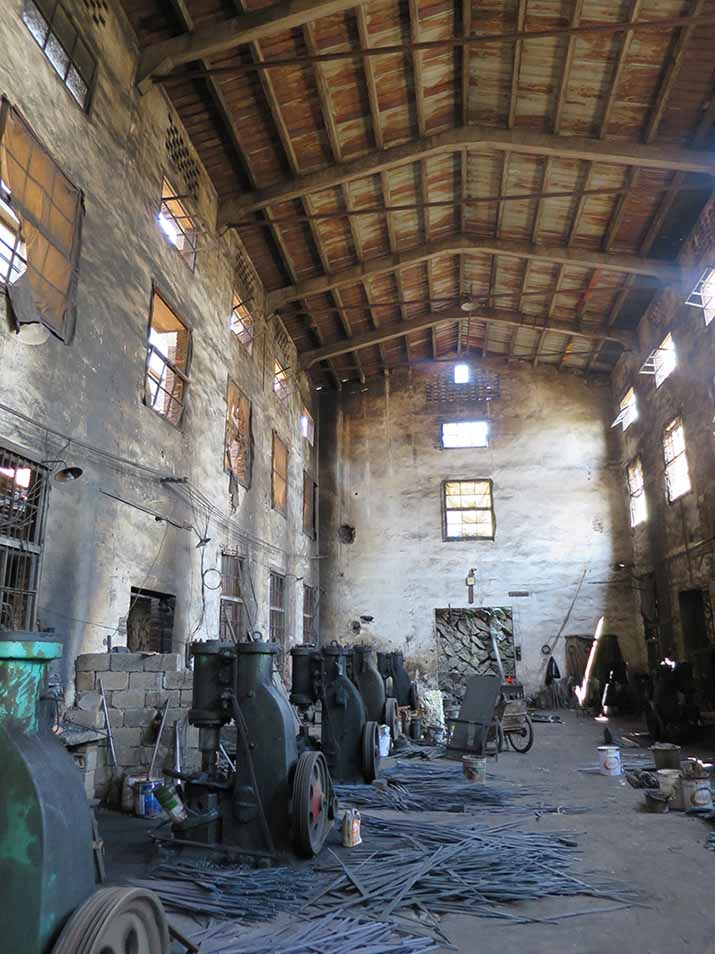 Steel Billets and Power Hammers in "Hammertown"
Steel Billets and Power Hammers in "Hammertown" The basic technique used here is to take billets of steel (usually 1045 carbon steel - marketing it as whatever steel is popular at the moment or "juicing" it by adding raw carbon to 'boost' it) and heat them until the steel becomes red hot and enters a malleable state.
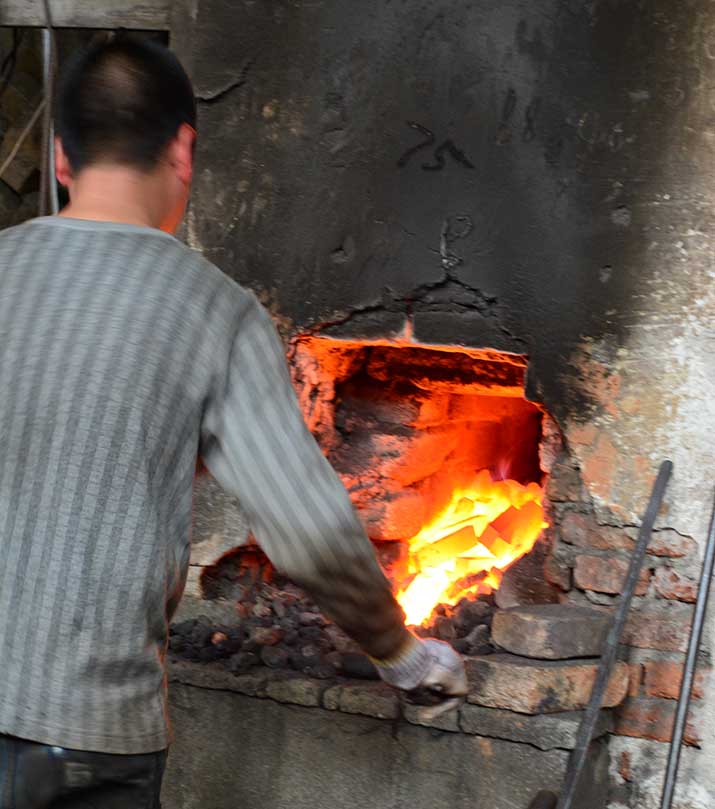
Then the billets are pounded out to the shape and length desired by a power hammer..
This is not necessarily a a bad thing in itself, power hammers are used to make high end Katana in Japan. But it is something to be aware of as many eBay sellers claim their swords are hand hammered by Master Smiths, implying someone is taking painstaking personal care of each blade when nothing could be further from the truth. For the most, the vast majority of sub $300 swords are just churned out rather soullessly..
 One of the Hammertown smiths using a power hammer
One of the Hammertown smiths using a power hammerIt is interesting to see how swords are made much faster this way with the least amount of sweat. And naturally, it is how the vast majority of swords being sold online are made - despite many eBay vendors claiming that they have their own forges or make the swords themselves.
Beware of eBay "Forges"
I have lost count of the number of times I have had people complain to be about the quality and business practices of the so called "forges" selling swords from China. As an interesting aside, we actually spent some time investigating the addresses of these so called forges in China provided by some major eBay sellers and found that in nearly every case, the address was a totally unrelated business.
Here is one of the most amusing, I will not name the business, but they are actually one of the supposed "better" eBay sellers..

I am not sure how they can forge a sword in there..
Of course, the truth is, they can't and they don't. They simply order from "Hammertown" (and as they do not order in quantity, getting the scraps, QC rejects and leftovers) and run their mystical sword forge as a side business..
Beware of eBay Forges - most are definitely not what they seem..
Your REAL cheapies (typically most swords under $100) aren't even made at Hammertown, they are simply stamped out of steel sheet and run through several specialized machines. I have been shown how swords are made in the fastest time possible this way, literally churning them out, and some of the shortcuts used are downright scary..
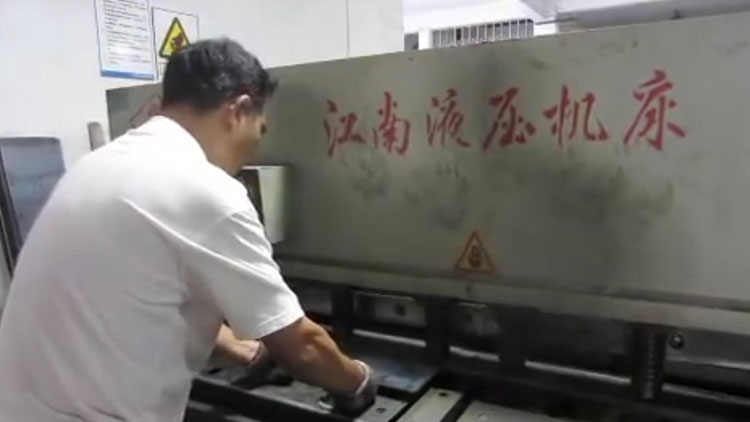 A press cuts sheet steel to size - it is then run through a series of machines that shape it and in a few minutes, an SLO (Sword Like Object) is born..
A press cuts sheet steel to size - it is then run through a series of machines that shape it and in a few minutes, an SLO (Sword Like Object) is born..For the most part, it is all an economy of scale. To truly understand how swords are made, the basic principle is that they are made to a predetermined budget. With machine made blades (which, devoid of human influence are rather 'perfect' but soulless cookie cutter things) there is a limit to what can be done - but with a forged blade, the question then becomes how far do you refine it - and when do you stop to meet the target price point?
If you understand this principle, then you will understand how swords are made across the board - you can buy pintos or Ferraris, but you can't realistically expect a Pinto to go as fast, handle as well or look as cool as a Ferrari - and the same principle is very true of swords.
So are any good swords made in China?
THREE RANKS OF MASTER
In addition to rank one (city level) master smiths there are two more levels, rank two, province level master and rank three, national treasure. Project X and Forge Direct, for example, works with rank 1 and 2 master smiths. Rank 2 swords can command prices of tens of thousands to millions of dollars. Rank 3 swords, many are literally priceless..
The short answer is of course a resounding YES.
What separates most serious sword companies apart from the fakes who pretend to run their own forge, but just grab what comes off the line at Hammertown, is that they commission their blades to be made by independent forges who are owned and run by certified master smiths, men who have taken a grueling 3-7 year apprenticeship, learned how to forge a sword in a variety of styles and techniques and passed the test to become a level one (city level) master.
Swords made at their forges are either made by skilled apprentices under the supervision of the Master Smith, or by the Master Smith themselves - typically rank one smiths, but sometimes even rank 2 smiths who prefer to spend their time at an anvil rather than in front of a computer screen.
 Skilled Apprentices make the majority of the affordable quality swords coming out of China
Skilled Apprentices make the majority of the affordable quality swords coming out of ChinaThese guys certainly know how to forge a sword by hammer and anvil. let's take one last look at the Chinese method and the various levels of sword production there with a video I shot on location in Longquan which will show you some of the techniques and methods in action.
Of course, its all well and good to know how the blades are made, but to properly understand how swords are made, you need to pay attention to the fittings too.
How Swords are Made in South East Asia
In Lonquan city there are forged of all sizes producing swords of all quality levels - from huge factories with hundreds of workers to mom and pop family run operations operating out of a shack.
But the size of a forge is certainly no indication of its quality - for example, Blade Culture International, otherwise known as B.C.I. is a small family run enterprise operating in the most out of the way location in Pangasinan, the Philippines using a single forge set in the wall and a small circular anvil a few feet away.
 BCI in the Philippines make every type of sword known to man on THIS tiny anvil..
BCI in the Philippines make every type of sword known to man on THIS tiny anvil..It was quite fascinating to see how swords are made in the Philippines. Their forges and workshops are tiny - not much more than a single forge, a few grinding machines and benches with various hand tools, and a whole lot of sweat and a huge amount of innovation and creativity.
Such small forges also exist in China too, but they are for the most part just puppets of the big forges. But these guys, they are true artisans. It truly is hard to believe that out of a workshop like this..
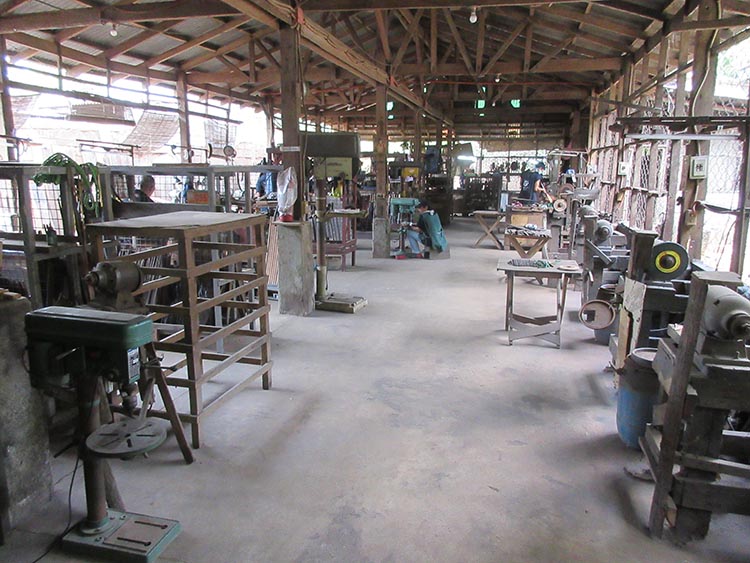 The BCI workshop in its entirety
The BCI workshop in its entiretythey can make swords like THIS
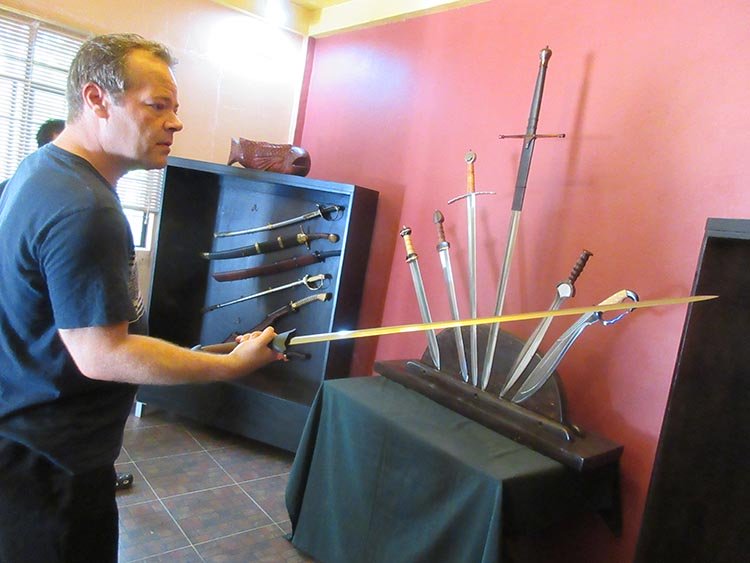
And a short hop across the South China Sea Citadel Swords in Cambodia have a pretty simple set up as well - using hand pumps and the same kind of round anvil - but produce swords of such quality that even the Japanese recognize their work!
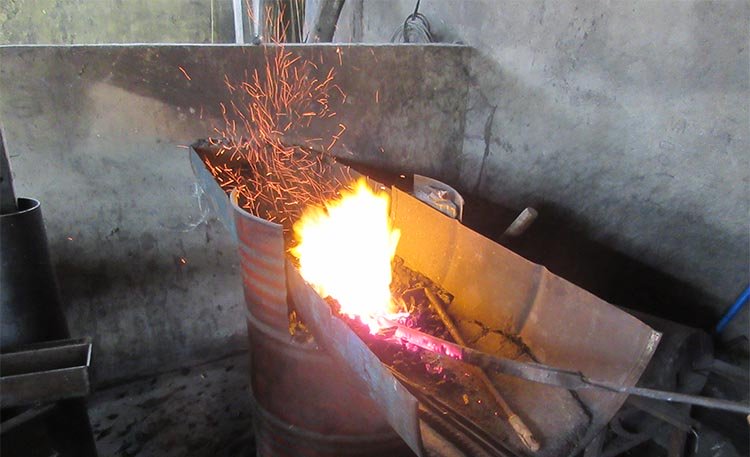 Hardening a Katana at Citadel Swords - nothing high tech here...
Hardening a Katana at Citadel Swords - nothing high tech here...There is nothing fancy about either of these forges, but the swords they make their belie their humble origins.
RELATED ARTICLES
Behind the scenes at two of the most famous and important micro forges in South East Asia - meet the people behind them, see their workshops and watch them make swords their way as if you were there.
Sword Making with Blade Culture International
A visit to a forge that has been running for over four decades and has produced the Philippines finest swords - and swords from every time period and culture. Just amazing how versatile and innovative these guys are with minimal tools and resources.
Citadel Knives and Swords, a visit to the Forge
Checking out THE premier maker of Japanese swords outside of Japan, Citadel Swords and Knives in Phnom Penh, Cambodia. The attention to detail here is out of this world, and truly what sets them head and shoulders above their competitors.
How Swords are Made in India
In terms of sheer volume, 90% of the swords you see for sale on the internet these days are made in either China, South East Asia or India. And India is quite an interesting one as they make swords not just for collectors, but some of them - such as Windlass Steelcrafts - are THE suppliers of presentation swords for the military's around the world (including the US marine core) - and have been since the late 1940s..
Much to their credit, they are quite open to show how swords are made at their facility as well - combining old fashioned techniques with state of the art equipment to produce quite affordable and nicely tempered swords.
Unfortunately for India, their export laws do not allow them to make or ship SHARPENED swords, so as a result - most are sharpened locally in the USA or elsewhere.
How Swords are Made in the West
While it is true that in terms of volume 90% of all swords are made in South, South East and East Asia, the USA, Canada, Australia and Europe make up a that last 10% - and as you might expect, for the most part they don't compete on price but instead concentrate on quality.
At the entry level there are small local businesses such as Scorpion Swords, Zombie Tools, BKS (Baltimore Knives and Swords) and other small up and coming small enterprises making extremely tough swords using the stock removal method.

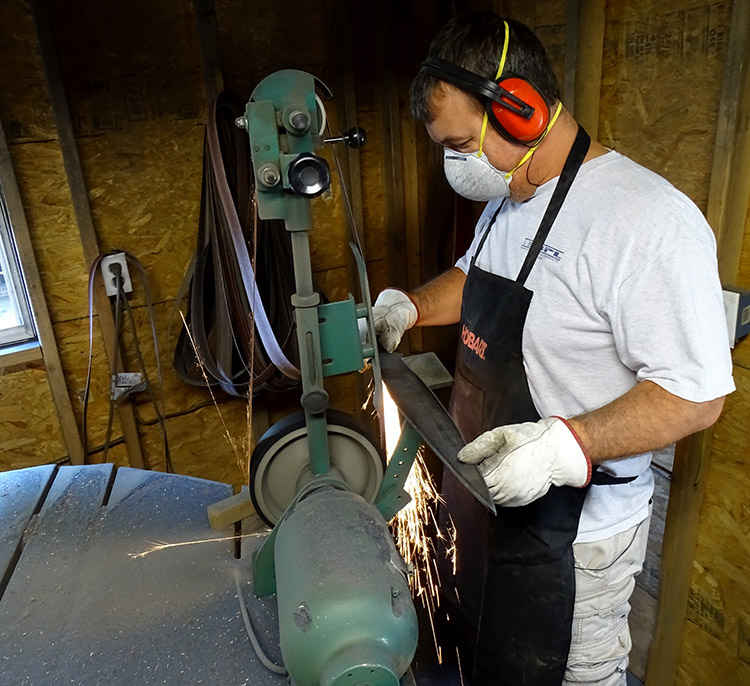

While the stock removal method is not traditional, it is faster and thus more affordable - to use the same techniques how swords are made in China that cost $300 would easily cost $1000 or more if it was made in the USA. And as the heat treat equalizes everything, there is no practical difference in terms of blade strength and blade integrity between a sword hand forged or a sword made via stock removal.
Higher end production swords made in the USA tend to be exclusively Western medieval or renaissance period blades (those few who make Japanese styled swords are all custom sword makers only). How swords are made at the higher end can vary, some bang away on hammer and anvil, others like Albion use advanced machinery such as CNCs.
VIDEO: How Swords are made at Albion
By using such equipment it is possible to produce a sword to the same exacting specifications every time, though price and waiting time can be an issue - with few swords under $1000 and an average wait time of 12 months or so.
How Swords are Made in Japan

Japan is not legally permitted to make any type of functional mass produced sword - the last such swords made this way were in 1945 at the end of world war II, and since then they have all been made by a handful of heavily regulated master smiths using Tamahagane steel from a single foundry.The only exception is for zinc aluminum iaito and mogito swords which cannot hold an edge and are only used for training purposes.
Power hammers ARE used for rough shaping, but the final shaping is all done with hammer and anvil and has a highly ritualized spiritual element to it. Because there are strict limits on how many swords can be made per month and the inherent time investment and incredible level of detail that goes into making them (Japanese tend to be perfectionists as a rule) how swords are made in Japan is not seen anywhere else in the world, and they are priced accordingly - with the lowest price for a new, modern made Nihonto or Shinken typically starting at around $4000 for a bare blade.
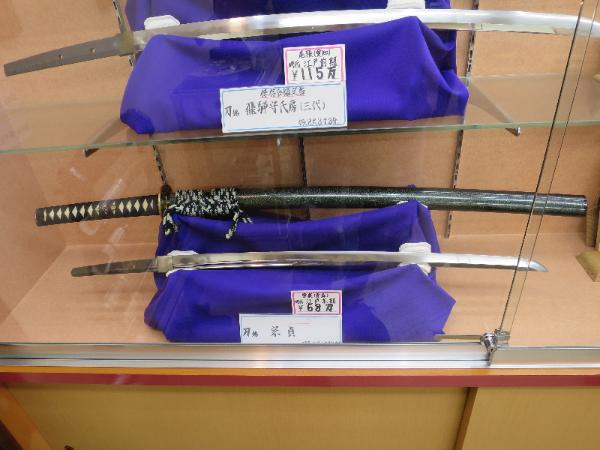 Bottom One is around $6K, top one around $11,000..
Bottom One is around $6K, top one around $11,000..What to expect - how swords are made to fit the final price tag
If you understand how swords are made, then you will have a much better idea of what is actually possible and reasonable at the different price points, and if a given sword actually represents good value or not.
At the end of the day, how swords are made and what level of refinement can be done depends entirely on how much it will sell for and how much it costs to make.
To try and give a practical example of this principle, let's take a look at Japanese swords..
Essentially, a Katana consists of 3 main parts and the actual blade. Those parts are the saya (sheathe), the tsuka (handle) and the tsuba (hand guard) - as well as few small bits and pieces like the habaki blade collar, seppa, etc (for an easy guide to Japanese sword terminology, click here)
The blade itself also has two main parts - the blade and the kissaki. All of these parts cost money to make and to polish - and how much money they cost depends on the base steel type and what level of refinement (time) you want to spend on it..
For an example, we have taken a product line we know very well - the Ryujin Custom Katana series - and broken the individual cost of each main parts grouping into it's cost and overall percentage of the parts value compared to the cost of the completed sword.
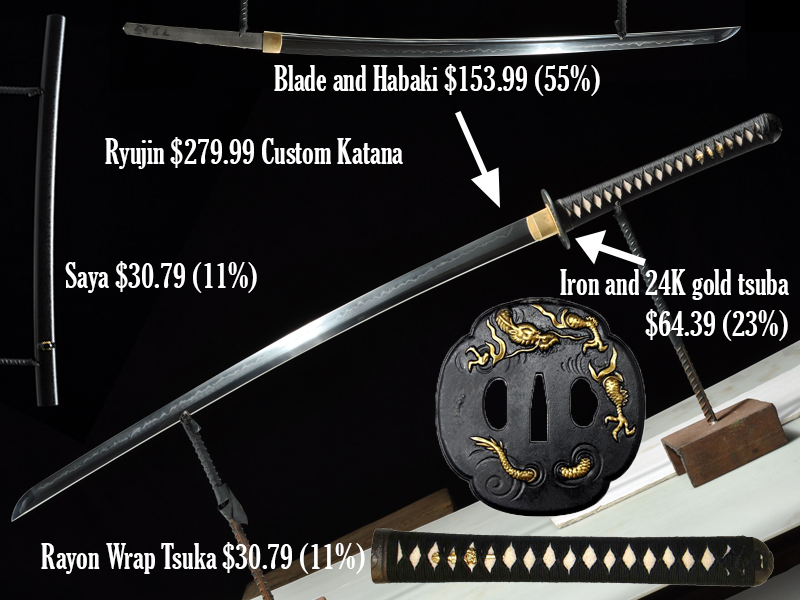
At the sub $300 price point, these swords are some of the best out of the box cutters on the market, and balanced quiet perfectly between the costs of the blade and the fittings to create a nice serviceable entry level dojo cutter (after all, a sword is only as strong as its weakest link).
Now if you understand how swords are made to the maximum quality possible at that price point, then you will understand that if more money is put into any of those 4 main components (blade, handle, sheathe and hand guard) the sword gets better but costs more..
For example, lets look at the blades. The blades (plus habaki) represent 55% of the products final price and so is worth $153.99 by itself. For that $153, you get a billet of quality T10 tool steel hand forged into a 3' length of steel, it is then ground into shape, taken away to be hand clayed and differentially hardened and tempered (heat treatment), checked for any cracks or failures in the quench, hand polished for few hours, quality checked one final time and finally coated in oil and a plastic sleeve before being sent off for final assembly to the customers specs at a California based warehouse.
The end result of all that work is a nicely made, extremely strong and reliable blade. But to have all that done and still cost $153 - you can't afford the master polisher who will work on it for a FULL DAY with Japanese water stones like you can on a $1000 Project X sword..
If you wanted to get the same exact style of blade hand forged by a certified master smith or their most senior apprentices and polished by the forges resident master polisher, at the very least you would need to TRIPLE the price of the blade ($141 x 3 = $423) and now this Katana that was formerly $280 is a $500 sword..
It could be argued that in doing this, the sword is going to be a little unbalanced because now the blade is head and shoulders in quality above the fittings, and to get it back in balance again, you would have to upgrade the fittings too..
So clearly, if you do all that, it simply isn't a $300 sword anymore - and this is exactly the case with our second example, a Ryujin ELITE which uses a much nicer blade than the previous model, but the fittings remain unchanged.

Many collectors do like to seek out swords that have great blades,
and have not been fully upgraded in the other parts as you can buy them
more affordably and are sometimes refered to as 'diamonds in the rough'.
At the other end of the spectrum, a poor quality blade is sometimes
paired with much better fittings and is colloquially refered to in the
sword veracular (oftentimes somewhat unfairly) as a 'polished turd'..
To really clearly understand this principle, let's look at one of the main parts of the sword - the tsuka handle.
Tsuka Construction at various price points
Generally speaking, the percentages given above are fairly accurate - and so the tsuka handle in general makes up 16% of a swords total value. Most tsuka have rayskin (called same) in either a paneled or full wrap..
 Rayskin (Same/Samegawa) is used on a Japanese sword under the handle - average price is $70 but goes up by the grade of the skin used
Rayskin (Same/Samegawa) is used on a Japanese sword under the handle - average price is $70 but goes up by the grade of the skin usedRayskin like this usually runs at about $70 per skin - and can be used to make ONE full wrap or around 5 or 6 if paneled and none of it is wasted. Here is a video which demonstrates what I mean and shows how swords are made with either a full or paneled wrap.
VIDEO: How Swords are Made Using Rayskin - Panels or Full Wraps
Now as we saw from the example above, the tsuka costs $50 - and is paneled - it HAS to be as the cost of a skin to do a full wrap is $70!
On the other hand, Citadel of Cambodia - whose Katana are recognized as some of the best outside of Japan - use a full wrap, make the tsuka core to fit that particular blade exactly, use imported Japanese silk - and cost around $2800 for the complete package - so at 16%, to make a tsuka as good as it can possibly be will cost around $448..(and that is based on Cambodian labor costs and costs of production, in the USA, Japan or Europe, this would cost considerably more!).
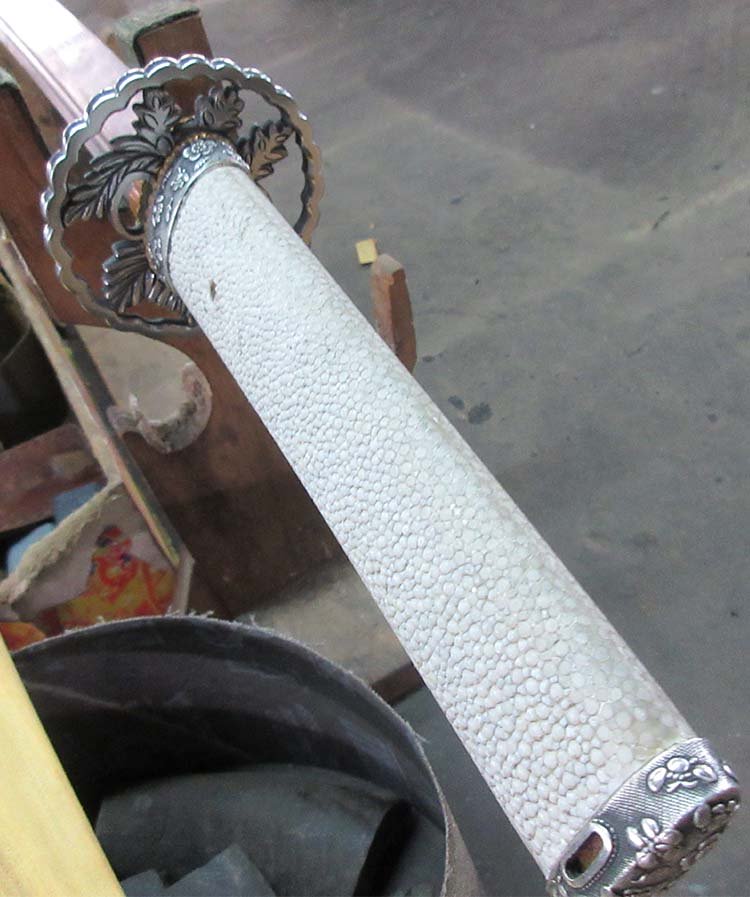 The full wrap of this Citdadel Tsuka uses one full rayskin
The full wrap of this Citdadel Tsuka uses one full rayskinAs such, this means that to make a tsuka handle as good as it can be costs the same as one and a half complete swords.
It is not uncommon for entry level Katana to have a tsuka that is very tightly hammered on that gets cracked if the wood swells or if too much force is used to remove it. But it is not necessarily the end of the world if it happens - read our full article 'cracked tsuka: the scourge of production katana?'
So at the end of the day, how swords are made and what price they will be sold for are inseparable - and it is critically important to understand what you are paying for any what to expect, otherwise you may have completely unrealistic expectations.
True enough, many sword collectors would prefer it if their sword had a custom fitted tsuka core made for their $300 sword, but don't want to pay the price to have it done.
But to be realistic, at the the end of the day you have two choices, buy a sword that is as good as it can possibly be for under $300 (and don't get me wrong, you can get a pretty darned solid sword for under $300) and either live with its inherent limitations, customize it yourself or buy a higher end sword..
Just as it would be a bit silly to go back to the Pinto dealer because their new Pinto isn't as fast as their friends Ferrari or does not handle quite as well, so it is equally silly to compare a perfectly made tsuka core that costs one and a half times as much as the entire sword of a sub $300 beater.,
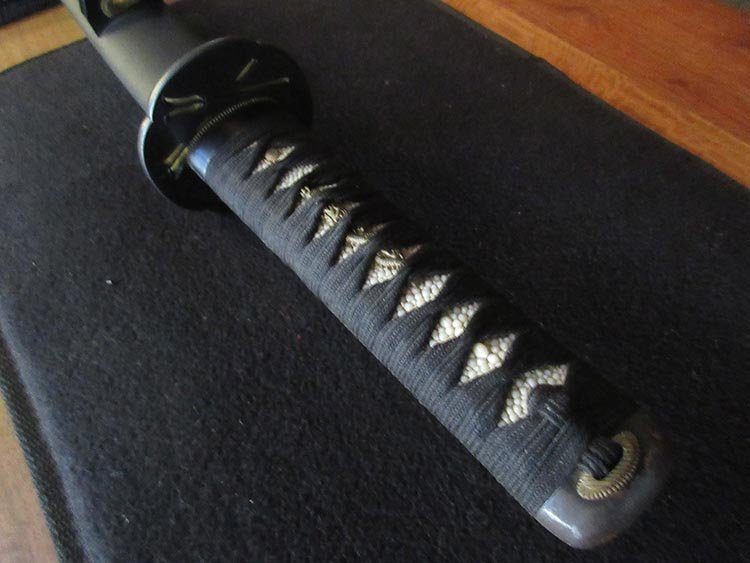 No expenses spared - a beautiful tsuka core on a Wakizashi from Citadel Swords of Cambodia. Full premium rayskin wrap, custom made handle core to fit that particular tsuka, imported Japanese silk ito wrapped with hishigami, hand made iron fuchi and kashira..
No expenses spared - a beautiful tsuka core on a Wakizashi from Citadel Swords of Cambodia. Full premium rayskin wrap, custom made handle core to fit that particular tsuka, imported Japanese silk ito wrapped with hishigami, hand made iron fuchi and kashira..Conclusion
As we said at from the outset, knowing how swords are made - and how swords are made within the limitations of the final selling price - is extremely important information that every sword collector or enthusiast needs to know to be able to make the most informed buying decision possible and avoid unrealistic expectations that may lead to disappointment.
Of course, it does not mean that one should settle for inferior products - even the cheapest functional swords need to meet a minimum standard, and while some imperfections are unavoidable and par for the course, it doesn't mean that sword sellers should be allowed to sell utter rubbish just because how swords are made to fit a given budget.
And by the same token, it doesn't mean that a more expensive sword will be stronger or cut better than a cheaper one, it is simply a case of refinement.
What it does mean however is that if you have champagne tastes on a beer budget, you either have to DIY it to improve the sword or accept the limitations inherent at the price point you are buying them at.
 A homemade DIY tsuka with perfect fit made using our DIY instructions - this was the makers FIRST ATTEMPT and to have it made elsewhere to this level would cost several hundred dollars.
A homemade DIY tsuka with perfect fit made using our DIY instructions - this was the makers FIRST ATTEMPT and to have it made elsewhere to this level would cost several hundred dollars.When you consider what goes into them and how swords are made with so many processes from start to finish, it really is quite a miracle that there is such a thing as sub $300 swords to begin with..
And for many of us, they are more than good enough..
Further Resources
If you are curious on how to make your OWN swords we have some good tutorials on making swords via the stock removal method here - and a ton of free step by step tutorials on how to customize both Medieval and Japanese style swords here.
YouTube has a ton of behind the scenes sword making videos showing you how swords are made, either in the backyard at home, by skilled artisans or at the various Asian sword forges we mentioned. One of the most entertaining is my 'Michael Cthulu' whose YouTube channel is here and he specializes in custom sword builds for gigantic over the top swords and fun testing at the end.
And quite a few sword manufacturers show how swords are made at their facilities and what to realistically expect if you visit their official websites (you can find the biggest and/or most important sword makers listed in the SBG sword manufacturers dossier).
Finally, you can talk to sword makers directly, see their latest builds and ask questions at our very own SBG Sword Forum or over at bladeforums.com
I hope this article on how swords are made been helpful. To return to the SBG Homepage from How Swords are Made, click here

Buying Swords Online Can Be DANGEROUS!
Find the Best Swords in the:
Popular & Recommended ARTICLES

The ONLY true free online magazine for sword enthusiasts. Delivered once a month on the 1st day of the month, no filler and no BS, just the latest sword news & info delivered straight to your inbox.


